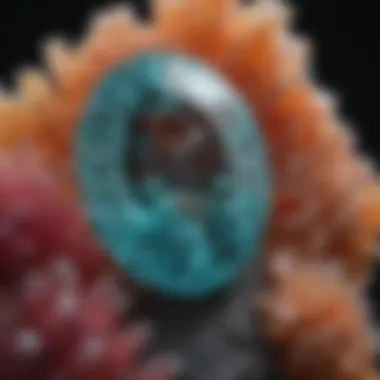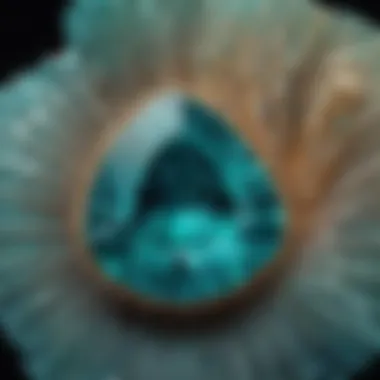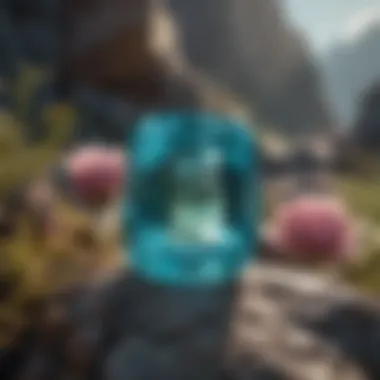Exploring Paraiba Tourmaline: Colors, Value & Insights


Intro
Paraiba tourmaline stands out in the realm of gemstones, fascinating both enthusiasts and collectors alike. Discovering what gives this gemstone its distinct characteristics, understanding its value, and exploring strategies for collection opens up a world of appreciation. This piece will delve into these aspects, enhancing understanding of Paraiba tourmaline and its appeal.
Rock and Fossil Identification
Identifying gems such as Paraiba tourmaline involves recognizing specific characteristics that set them apart. While this section focuses primarily on identification methods, some insights can apply to other minerals as well.
Types of Rocks and Fossils
Paraiba tourmaline is not easily confused with fossils, but understanding its geological background is crucial. The gemstone originates from unique volcanic and igneous formations, primarily found in Brazil. The vivid colors are a result of copper, forming a stark contrast to more conventional tourmaline varieties.
Characteristics to Look For
- Color: Shades of turquoise to vivid blue and green are predominant in high-quality Paraiba tourmaline. Vividness of color often indicates higher value.
- Clarity: Transparency is important. Flaws can reduce desirability.
- Cut: The craftsmanship of the cut can enhance the gem's overall appearance.
Tools for Identification
Using the right tools is essential for accurate identification:
- Magnifying loupe for examining inclusions and clarity.
- Gem tester to measure properties like refractive index.
Collecting Tips and Techniques
Collecting Paraiba tourmaline requires both knowledge and strategic planning. Here are some useful practices to ensure successful acquisition.
Best Practices for Collecting
- Always source your stones from reputable dealers. Authenticity matters.
- Compare stones side by side when shopping to discern quality differences.
Locating Prime Collecting Sites
Searching for Paraiba tourmaline requires geographical knowledge. The most notable sites include:
- The Paraiba state in Brazil.
- Other locations in Africa and Nigeria might also yield quality stones.
How to Safely Extract Specimens
If you venture into gem hunting, ensure you:
- Use appropriate tools like chisels.
- Adhere to local regulations regarding collection of stones.
Preservation and Display
Once collected, effectively preserving and displaying Paraiba tourmaline can add to its beauty and value.
Techniques for Preserving Rocks and Fossils
- Store in a cool, dry place to avoid any damage.
- Use acid-free paper or pouches to protect individual stones.
Proper Storage Methods
- Display Cases: Use glass display cases to showcase your collection.
- Soft Cloth: Wrap each stone in soft cloth to avoid scratches during storage.
Creative Display Ideas
Considering aesthetically pleasing displays can enhance appreciation:
- Arrange stones by color for visual contrast.
- Use lighting to highlight the gemstone’s facets.
Geological Insights


Understanding Paraiba tourmaline’s geological context enriches the collector's knowledge. Learning about the processes that lead to its formation can deepen appreciation.
Geological Formations and Processes
Paraiba tourmaline forms in specific geological environments, primarily in volcanic and metamorphic areas. These conditions contribute to its unique colorations and characteristics.
Historical Significance of Rocks and Fossils
The discovery of Paraiba tourmaline in the 1980s transformed the gemstone market. It rode on a wave of fascination due to its vibrant hues and scarcity.
Notable Discoveries in the Field
Collectors have found remarkable specimens over the years. Each discovery contributes to the lore and excitement surrounding Paraiba tourmaline, emphasizing its elusive nature.
The uniqueness of Paraiba tourmaline is reflected in its journey from the earth to the collector's cabinet.
By recognizing these aspects, enthusiasts can develop a comprehensive understanding of Paraiba tourmaline, enhancing their collecting experience.
Understanding these traits will guide collectors in valuing and appreciating this captivating gemstone.
Prelude to Paraiba Tourmaline
Paraiba tourmaline holds a significant place in the realm of gemstones. This unique mineral is not only prized for its striking colors but also for the rich history and geological context surrounding it. Understanding Paraiba tourmaline involves exploring its historical background and geological significance, which together paint a comprehensive picture.
The allure of Paraiba tourmaline comes from its vibrant hues, often ranging from neon blue to green. This enchanting color arises from trace elements like copper, setting it apart from other tourmaline varieties. Given its beauty and rarity, it is crucial for collectors and enthusiasts alike to understand not just its characteristics, but also the circumstances around its discovery and formation.
Historical Background
The history of Paraiba tourmaline is as fascinating as its aesthetic appeal. Discovered in the late 1980s in the state of Paraiba, Brazil, this gem quickly captured the attention of gemstone lovers and jewelers around the world. The first stones were found near the municipality of São José da Batalha. Its initial introduction to the market created a stir due to its unique coloring and distinctive luminescence, which had never been observed in tourmaline before.
The rapid rise in its desirability can be attributed to its limited supply and geographical uniqueness. The scarcity of Paraiba tourmaline has only intensified over the years, escalating its value significantly. Furthermore, the gemstone's connection to its place of origin adds a layer of significance, making it more than just a collector's item; it becomes a piece of a specific geographic and historical narrative.
Geological Significance
Paraiba tourmaline's geological formation process contributes immensely to its value and appeal. Formed in a specific type of granite, this mineral originates in pegmatitic environments where the right conditions for intense color development exist. The presence of copper and manganese does not occur in all tourmaline deposits, making it exceptional.
The minerals that form alongside Paraiba tourmaline also speak to its geological importance. Its formation gives insights into the conditions present in the Earth's crust during its crystalline growth. Additionally, the unique deposit locations, primarily in Brazil but also in Mozambique and Nigeria, highlight the global interest and quest for this gemstone. The variance in location also introduces subtle differences in color and clarity, something that collectors must consider when assessing their value.
"Understanding the geological context of Paraiba tourmaline enriches not only the appreciation of its beauty but also highlights the mineral's place within Earth's history."
Physical Characteristics of Raw Paraiba Tourmaline
The physical characteristics of raw Paraiba tourmaline plays a critical role in defining its desirability and value. This gemstone exhibits distinct features that set it apart from other varieties of tourmaline. Understanding these characteristics is essential for anyone looking to collect or invest in this remarkable mineral. The key elements include variations in color, level of clarity and transparency, and crystal structure. Each of these factors holds significant weight in determining the overall quality and market value of Paraiba tourmaline.
Color Variations
Color is perhaps the most enchanting aspect of Paraiba tourmaline. It is well-known for its vibrant hues, ranging from electric blue to neon green. The intensity and saturation of these colors are influenced by the presence of copper and manganese during the formation process.
Distinct color variations exist within this gemstone. For example, some stones may display a more intense blue, while others might lean towards a vivid green or even a bluish-green. Here are some key points relevant to the color of Paraiba tourmaline:
- Electric Blue: The most sought after shade, often correlating with higher values.
- Greenish Tints: These variations can be attractive but typically are considered less valuable than pure blue varieties.
- Color Shift: Some Paraiba stones exhibit a shift in color under different lighting conditions, which can be a unique quality valued by collectors.
The unique visual appeal derived from these color variations greatly enhances the desirability of Paraiba tourmaline, making it a prized item for gemstone collectors.
Clarity and Transparency
Clarity is another major characteristic of Paraiba tourmaline that impacts its value. High-grade specimens typically exhibit excellent transparency with minimal inclusions. Each clarity grade influences the stone's brilliance and overall aesthetic appeal.
Inclusions, which can sometimes occur, may affect how light interacts with the stone. Here are some aspects worth considering regarding clarity and transparency:
- Type of Inclusions: The presence of certain inclusions, such as rutile needles, can either detract from or contribute to the beauty of the stone.
- Grade Classification: Paraiba stones are often classified in tiers ranging from "included" to "flawless." Flawless stones command the highest prices.
- Light Performance: The degree to which a stone allows light to pass through enhances its shimmer and depth.
Clarity and transparency significantly affect both the visual charm and the investment potential of Paraiba tourmaline, making them crucial elements to assess for collectors.


Crystal Structure
The crystal structure of Paraiba tourmaline adds additional layers of complexity to its identity. This mineral belongs to the hexagonal crystal system, characterized by a unique arrangement that contributes to its physical properties. Understanding the crystal structure is vital for both collectors and jewelers.
Key points about the crystal structure include:
- Crystalline Habit: The stones typically form in elongated crystals that can be prismatic. This unique shape contributes to breaking light in a visually appealing way.
- Mohs Hardness: Paraiba tourmaline has a hardness of 7 to 7.5 on the Mohs scale, making it suitable for jewelry usage while being relatively durable.
- Piezoelectric Properties: This gemstone can generate an electrical charge when subjected to pressure, a feature not found in many other gemstones.
Understanding the crystal structure can offer insights into the stone's value, durability, and the care needed for maintenance.
In summary, the physical characteristics of Paraiba tourmaline – including its stunning color variations, clarity, and unique crystal structure – are key considerations for collectors and investors alike. The appeal and rarity of this gemstone are enhanced by these distinctive traits, making it a valuable addition to any collection.
Geological Formation and Origin
Understanding the geological formation and origin of Paraiba tourmaline is crucial for several reasons. This knowledge helps enthusiasts appreciate the stone's rarity and its distinct characteristics. Moreover, recognizing the origins contributes to the value assessment of the gemstone. Each tourmaline holds a unique story, tied deeply to the ecological conditions in which it formed. Knowing this background not only enhances its aesthetic appeal but also informs collectors about the provenance of their specimens.
Formation Process
The formation of Paraiba tourmaline primarily occurs in igneous rocks through a complex process involving magma cooling and crystallization. However, the specific elements that contribute to its unique coloration primarily include copper and manganese. These trace elements seep into the crystal structure during formation, leading to the vivid blues and greens that Paraiba tourmaline is celebrated for.
Notably, the mineral's crystallization occurs in pegmatitic environments. These slow-cooling intrusions allow for the growth of large, well-formed crystals. The presence of gem-grade crystals often depends on the surrounding geological conditions and the right mix of minerals.
Notable Locations
Paraiba tourmaline is predominantly found in Brazil, specifically in the Paraiba state. This region is renowned for producing some of the most beautiful and vivid stones. Besides Brazil, notable deposits of Paraiba tourmaline can also be found in Nigeria and Mozambique. Each location has its particular conditions that influence the stone's final appearance.
The geographic diversity results in slight variations in color and clarity. For instance, Nigerian stones may offer more greenish hues compared to their Brazilian counterparts, which often boast a more intense blue.
In sum, the geological formation and the unique locations that yield these precious stones are integral to one’s understanding of Paraiba tourmaline. They provide context not only to the geological processes involved but also help collectors assess the quality and value of their pieces.
Market Valuation of Paraiba Tourmaline
Understanding the market valuation of Paraiba tourmaline is crucial for collectors, investors, and enthusiasts alike. The valuation reflects not just the aesthetic qualities of the gem but also its rarity, historical significance, and current demand. As the market continues to evolve, being informed of the factors that influence price and investment potential can empower individuals to make smarter decisions regarding their collections.
Factors Influencing Value
Several key elements impact the value of Paraiba tourmaline:
- Color: One of the most significant factors is the hue. Paraiba tourmaline is known for its neon blue and green shades, often compared to the vividness of the Caribbean Sea. The more intense and vibrant the color, the higher the value.
- Clarity: The presence of inclusions affects the visual appeal and overall price. Stones with high clarity, showing little to no inclusions, attract top prices in the market.
- Carat Weight: Larger stones are generally rarer and command higher prices. However, the weight alone is not sufficient; color and clarity must be equally considered.
- Origin: The source of the stone matters. Paraiba tourmaline from the original Brazilian deposits often holds the highest value, while stones from newer locations, such as Mozambique, may be valued differently.
- Market Demand: Trends in the sapphire and gemstone markets can influence value. Increased demand can elevate prices, while decreased interest can lead to lower valuations.
"A gem's value is not only in its physical characteristics but often in the allure and stories behind it."
Investment Potential
The investment potential of Paraiba tourmaline is noteworthy. This gemstone operates within the luxury goods market, where rarity and demand can result in significant appreciation over time. Collectors should take into account:
- Long-Term Value: Historically, high-quality Paraiba stones have shown robust performance in the market. Their unique qualities often place them at a premium compared to other gems.
- Market Trends: Keeping an eye on trends in both the gemstone markets and broader financial contexts can yield insights into timing purchases or sales.
- Diverse Investment Portfolio: Incorporating Paraiba tourmaline into a collection not only enhances its value aesthetic but also diversifies the investment portfolio.
- Potential Risks: Like any investment, there are risks involved. Market volatility can affect gemstone values, and not all stones will appreciate.
Investors and collectors must remain vigilant in research and appraisal practices to truly harness the potential of Paraiba tourmaline.
The Role of Treatment and Enhancement
The treatment and enhancement of gemstones, including Paraiba tourmalines, plays a crucial part in their marketability and valuation. Understanding these processes is essential for collectors, investors, and enthusiasts alike. As the demand for Paraiba tourmaline rises, so too does the prevalence of treatments designed to improve appearance. This section will delve into the distinction between natural and treated stones, as well as the implications treatment has on their value.
Natural vs. Treated Stones
Natural Paraiba tourmaline is characterized by its unique qualities that arise from geological processes. In its unaltered state, the stone displays vivid colors and clarity that makes it highly prized.
On the other hand, treated Paraiba tourmaline undergoes processes that may enhance its visual appeal. The most common treatments include heat treatment and oiling, aimed at improving color saturation and clarity. Collectors must be vigilant, as these enhancements can affect the intrinsic value of the gem. The following points summarize the differences:
- Natural Stones:
- Treated Stones:


- Rare and typically command higher prices.
- Maintain their geological integrity.
- More widely available and often less expensive.
- May have reduced long-term value depending on the treatment.
"Natural stones reflect their geological journey. Treated stones, while beautiful, present a narrative altered by human influence."
Recognizing the differences between natural and treated stones is crucial for any collector aiming to build a valuable collection.
Impact of Treatments on Value
The value of Paraiba tourmaline is significantly influenced by whether it has been treated or remains natural. Notably, untreated stones are viewed as more desirable in the eyes of collectors and investors. Here are some factors to consider:
- Market Demand: The market tends to favor natural, untreated stones, which combined with their rarity, often increases their price premium.
- Treatment Method: Different enhancement methods yield varying impacts on value. For example, aParaiba tourmaline that has been merely heated may retain more value than one subjected to dyeing or extensive treatment.
- Certification: Stones with certification from reputable gemological laboratories indicating their natural state can achieve higher prices. Documentation of treatments, when available, provides transparency and influences buyer trust.
Navigating the Collectible Market
Navigating the collectible market for Paraiba tourmaline is crucial for both enthusiasts and investors. This segment of the gemstone industry is nuanced, requiring a keen understanding of authenticity, sourcing, and valuation. Collectors are often drawn to Paraiba tourmaline because of its rarity and stunning color. However, making informed decisions in this market demands diligence and knowledge.
Identifying Authenticity
The importance of authenticity in the Paraiba tourmaline market cannot be overstated. With the rise in demand, counterfeit or misrepresented stones have also become common. Collectors need to ensure that they are purchasing genuine Paraiba tourmaline, which is identified by its vibrant colors and the presence of copper, a differentiator from other tourmalines.
To verify authenticity, collectors should consider the following steps:
- Certification: Look for stones that come with a certification from recognized gemological laboratories, such as the Gemological Institute of America (GIA) or the American Gem Trade Association (AGTA). These certifications confirm the stone’s origin and specific characteristics.
- Reputable Dealers: Buy only from established gem dealers who have a good reputation within the community. Research reviews and seek recommendations from other collectors.
- Visual Inspection: Familiarity with the gem’s typical appearance is beneficial. Paraiba tourmaline is known for its striking neon blue to green shades, which should be vivid and evenly distributed. Inclusions may be present, but they should not detract from the overall beauty of the stone.
"Authenticity is not merely a concept in the market; it is the foundation upon which trust and value build."
Sourcing Raw Paraiba Tourmaline
Sourcing raw Paraiba tourmaline can be a rewarding aspect of collecting. Understanding where to find high-quality stones requires exploration and knowledge of producing regions. The original mines in Brazil remain the most sought after, but significant deposits have also been located in Nigeria and Mozambique.
When sourcing, consider the following:
- Local Miners: Engaging with local miners or small-scale operations can lead to unique finds. They often sell stones directly, offering competitive pricing without markup by larger dealers.
- Gem Shows: Attend gem and mineral shows where many dealers gather to showcase their collections. This provides a platform to view a variety of stones and establish connections with reputable sellers.
- Online Platforms: Explore online marketplaces and forums where collectors exchange stones or offer them for sale. Websites like Reddit have communities dedicated to gem collecting, where members can offer insights on sourcing and authenticity.
Display and Preservation Techniques
In the context of collecting Paraiba tourmaline, the display and preservation techniques are vital for maintaining the integrity and beauty of these stunning gems. Proper techniques not only enhance the aesthetic appeal but also protect the stone from damage and degradation over time. For collectors, understanding how to effectively store and clean their tourmaline is crucial. This ensures not only the preservation of the object but also its value, particularly in a market where aesthetics and condition significantly influence pricing.
Optimal Storage Conditions
To ensure the longevity of Paraiba tourmaline, it’s essential to maintain optimal storage conditions. These gemstones should ideally be stored in a cool, dry place away from direct sunlight. Heat and humidity can lead to discoloration or physical changes in the stone. Some key considerations include:
- Temperature and Humidity: Aim for a temperature between 60°F to 75°F. Humidity should be around 40% to 50%.
- Containers: Use fabric-lined boxes or soft pouches to prevent scratches. Avoid plastic, as it can trap moisture.
- Positioning: Store stones separately to prevent contact that may lead to chips or scratches. A padded jewelry box or individual compartments keeps them safe.
Cleaning and Maintenance
Cleaning Paraiba tourmaline requires a careful approach to avoid compromising its quality. Regular maintenance is necessary but should be done gently. Here are some recommended practices:
- Gentle Cleaning: Use a soft, damp cloth to wipe the stone periodically. For deeper cleaning, a mixture of mild soap and water can be helpful.
- Avoid Harsh Chemicals: Steer clear of ammonia or abrasive cleaners, as these can damage the surface of the gemstone.
- Professional Care: For stubborn dirt or residue, consulting a professional jeweler familiar with gemstones is a wise decision. This helps ensure the stone is treated properly without risking damage.
"Proper care is crucial; a well-maintained gemstone retains its allure and value."
With careful storage and diligent cleaning practices, collectors can ensure their Paraiba tourmaline pieces remain as captivating as the day they acquired them.
Finale
The conclusion serves as a pivotal part of understanding the allure and complexities surrounding Paraiba tourmaline. For collectors and enthusiasts, it encapsulates the core insights gleaned throughout the article, emphasizing the gemstone’s significance. Recognizing the intricate details about its origins, characteristics, and market trends reinforces the value of investing time and resources into this mesmerizing stone.
Future Trends in Paraiba Tourmaline
As the market for gemstones continues to evolve, it is crucial to observe upcoming trends in Paraiba tourmaline collection and valuation. A growing awareness of sustainability in sourcing practices is reshaping the landscape. Collectors are likely to prioritize stones from responsible sources, affecting demand and possibly shifting price points. Additionally, technological advances in gemology, including enhanced detection of treatments and synthetic counterparts, will likely play a significant role in discerning valuable specimens from lesser variants.
Moreover, the increasing globalization of the gem market means that new collectors from diverse regions are entering. This influx will likely propel the recognition and appreciation of Paraiba tourmaline's unique qualities, further driving its demand.
Final Thoughts on Collecting
Collecting Paraiba tourmaline can be a rewarding endeavor. Understanding its characteristics, valuation, and treatment implications is fundamental. A discerning collector should invest in education and cultivate relationships with reputable dealers. This knowledge helps in identifying authentic stones and fair pricing. Also, joining communities online, such as those found on Facebook or Reddit, can provide invaluable insights into current market trends and best practices for storage and care.







